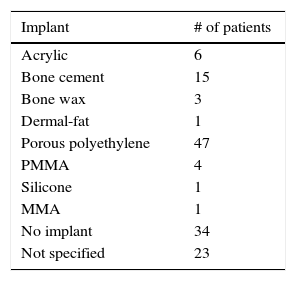Evisceration is currently becoming the technique of choice in the treatment of certain eye diseases, including, among others, painful blind eye and endophthalmitis. The most widely used implants are currently the hydroxyapatite and porous polyethylene for the rehabilitation of the anophthalmic socket.
ObjectiveTo describe the indications, type of implant material used, and complications in evisceration surgery.
MethodsA retrospective, observational, descriptive study based on clinical records of patients that underwent evisceration between 2008 and 2015 in the Instituto Fundación Conde de Valenciana, Mexico.
ResultsA total of 186 evisceration surgeries were performed, of which 52.7% of the patients were men. The mean age was 54 years. The right eye was eviscerated in 53% of cases, and 79.2% had a vision of no light perception. Most patients had preoperative pain.
The most common diagnosis for which evisceration was performed was endophthalmitis. Phthisis bulbi was reported in 20 eyes.
A primary implant was inserted in 86.81% of the cases, with 34.81% of the implants being made of porous polyethylene.
Four cases showed extrusion of the implant, with 2 cases of porous polyethylene.
The ocular prosthesis was tolerated in 91% of cases. There were no cases of sympathetic ophthalmia.
ConclusionEvisceration is shown to be a good alternative to enucleation in cases where the sclera can be preserved, showing a low incidence of sympathetic ophthalmia.
En la actualidad la evisceración se está convirtiendo en la técnica de elección en el tratamiento de ciertas enfermedades oculares, como un ojo ciego doloroso, endoftalmitis, entre otras. Para la rehabilitación de la cavidad anoftálmica los implantes más utilizados actualmente son los de hidroxiapatita y polietileno poroso.
ObjetivoDescribir las indicaciones, tipo de material del implante utilizado y complicaciones en la cirugía de evisceración.
MétodosEstudio retrospectivo, observacional, descriptivo, basado en expedientes clínicos de pacientes sometidos a evisceración entre 2008 y 2015 en el Instituto Fundación Conde de Valenciana.
ResultadosSe realizaron 186 cirugías de evisceración. El 52,7% de los pacientes eran hombres. El promedio de edad fue 54 años. El ojo derecho fue eviscerado en el 53% de los casos, el 79,2% presentaba una visión de no percepción de luz. La mayoría presentaba dolor preoperatorio.
El diagnóstico más frecuente por el cual se realizó la evisceración fue endoftalmitis. Se reportaron 20 ojos en phthisis bulbi.
En el 86,81% de los casos se colocó un implante primario. El 34,81% fue de polietileno poroso.
Cuatro casos presentaron extrusión del implante, en 2 casos de polietileno poroso.
La prótesis ocular fue tolerada en el 91% de los casos. No hubo casos de oftalmía simpática.
ConclusiónLa evisceración se muestra como una alternativa a la enucleación en casos donde la esclerótica pueda preservarse, mostrando baja incidencia de oftalmía simpática.












